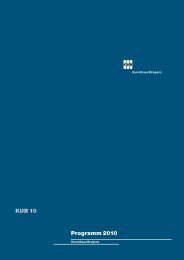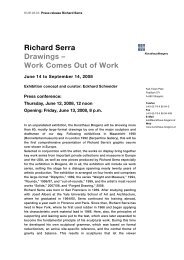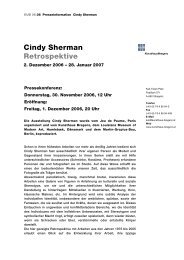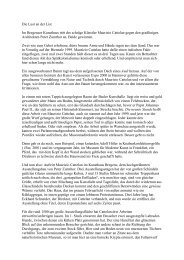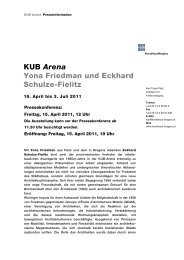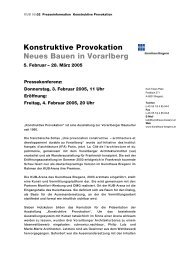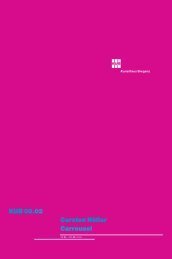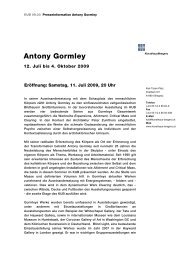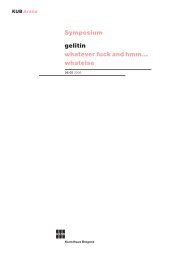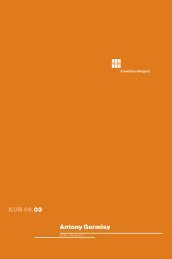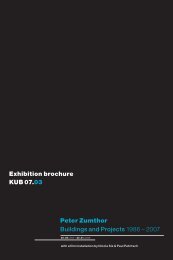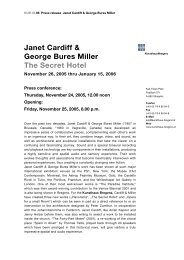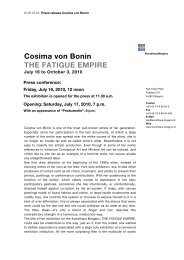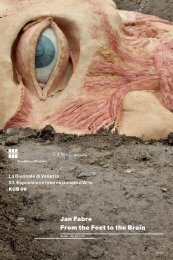KUB 08.03 Richard Serra Drawings Work Comes Out of Work
KUB 08.03 Richard Serra Drawings Work Comes Out of Work
KUB 08.03 Richard Serra Drawings Work Comes Out of Work
Erfolgreiche ePaper selbst erstellen
Machen Sie aus Ihren PDF Publikationen ein blätterbares Flipbook mit unserer einzigartigen Google optimierten e-Paper Software.
<strong>Richard</strong> <strong>Serra</strong><br />
out-<strong>of</strong>-round XII | 1999<br />
Ölkreide auf Hiromi-Papier<br />
201,3 x 201,3 cm<br />
The Museum <strong>of</strong> Modern Art,<br />
New York.<br />
Fractional and promised gift<br />
<strong>of</strong> Leon D. Black, 2000<br />
Foto: Rob McKeever<br />
Summary<br />
In an unparalleled exhibition, the Kunsthaus Bregenz will be showing<br />
some 60, mostly large-format drawings by one <strong>of</strong> the major sculptors<br />
and draftsmen <strong>of</strong> our day. Following exhibitions in Maastricht<br />
1990 and in London 1992, this will be the fi rst comprehensive presentation<br />
<strong>of</strong> <strong>Richard</strong> <strong>Serra</strong>’s graphic oeuvre ever shown in Europe.<br />
Selected in conjunction with the artist, the works on display<br />
bring together key work series from important private collections and<br />
museums in Europe and the USA, as well as new pieces produced<br />
by <strong>Richard</strong> <strong>Serra</strong> especially for the exhibition. All in all, the show<br />
includes six series, setting the stage for a dialogue spanning nearly<br />
20 years. The exhibition is arranged on four levels and comprises the<br />
large-format “Diptychs,” 1989, the series “Weight and Measure,”<br />
1994, “Rounds,” 1996/97, and “out-<strong>of</strong>-rounds,” 1999, and the artist’s<br />
most recent works “Solids,” 2007/08, and “Forged Drawing,” 2008.<br />
<strong>Richard</strong> <strong>Serra</strong> was born in San Francisco in 1939. After studying<br />
painting with Josef Albers at the Yale University School <strong>of</strong> Art<br />
and Architecture, where he graduated in 1964/65, <strong>Serra</strong> continued<br />
his training abroad, spending a year each in Florence and Paris.<br />
Since then, <strong>Richard</strong> <strong>Serra</strong> has lived in New York, where he began<br />
applying his characteristic work material lead in 1968. Here, also,<br />
the principles <strong>of</strong> supporting and leaning were put to the test, which<br />
were later expanded to become the fundamental principle <strong>of</strong> his<br />
sculptural work. During this time, he developed his own sculptural<br />
grammar, which was based on formal reductionism, an active sitespecific<br />
reference, and the central theme <strong>of</strong> gravity and balance.<br />
<strong>Serra</strong>’s first solo exhibition in 1969 at the Leo Castelli Gallery<br />
in New York was followed by many large international presentations<br />
<strong>of</strong> his sculptural work, landscape projects, and site-specific<br />
installations using his most primal material: steel. After his largescale<br />
retrospective at the Museum <strong>of</strong> Modern Art in 2007, <strong>Richard</strong><br />
<strong>Serra</strong> is currently showing “Promenade,” the monumental sculptural<br />
he created for the Grand Palais in Paris.<br />
Since 1971, <strong>Serra</strong> has focused not only on sculptural works,<br />
but also on large-scale drawings using various techniques. These<br />
work series are as important to him as his sculptures: “I like draw. It<br />
is an activity I rely on, a dependency <strong>of</strong> sor ts. […] It is an activity<br />
that requires solitude, it is the most concentrated space in which<br />
I work.” (R. <strong>Serra</strong>)<br />
The color <strong>Serra</strong> uses in his drawings is black. A dense layer <strong>of</strong><br />
paintstick absorbs and dissipates light; what emerges is the mass,<br />
density, and volume <strong>of</strong> the drawing. “Black is a property, not a quality.<br />
In terms <strong>of</strong> weight, black is heavier, creates a larger volume, holds itself<br />
in a more compressed field. It is comparable to forging. […] To use<br />
black is the clearest way <strong>of</strong> marking against a white field.” (R. <strong>Serra</strong>)<br />
10 11 <strong>KUB</strong>-Programm <strong>08.03</strong> <strong>Richard</strong> <strong>Serra</strong>



